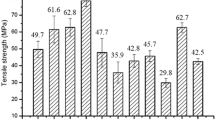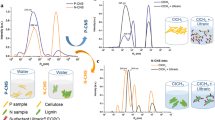Abstract
Due to increasing environmental concerns related to bio-persistence of petroleum based polymers, and the fact that most biopolymers such as polysaccharides or bio-polyesters are hydrophilic, hydrophobic biodegradable composite consisting of natural cellulosic fiber matrix and bio-derived polyhydroxyalkanoate (PHA) were fabricated by dip-coating, in which PHA was grafted using maleic anhydride to improve its compatibility with cellulosic fibers. It was found that there was a balance between the hydrophobicity of the complex and the grafting degree of MA on PHA. The composite film reached the highest contact angle of 130° at the grafting degree of 0.05% and the ratio of biopolymer to fibers 15%, and it was found to withstand the time aging without loss of hydrophobicity. The tensile strength of the composite film was greatly improved as a result of the introduction of PHA. This hydrophobic composite can potentially be used as a substitute for synthetic polymer/cellulose composite materials.









Similar content being viewed by others
Abbreviations
- PHA:
-
Polyhydroxyalkanoate
- PHA-g-MA:
-
Polyhydroxyalkanoate grafted maleic anhydride
- PLA:
-
Polylactic acid
- ATRP:
-
Atom transfer radical polymerization
- BPO:
-
Benzoyl peroxide
- MA:
-
Maleic anhydride
- ISO:
-
International Organization for Standardization
- ATR-FTIR:
-
Attenuated total reflectance fourier transform infrared spectroscopy
- SEM:
-
Scanning electron microscope
- CA:
-
Contact angle
- ASTM:
-
American Society of Testing Materials
- TGA:
-
Thermogravimetric analyzer
- CF:
-
Cotton fiber
References
Abdul Khalil HPS, Bhat IUH, Jawaid M, Zaidon A, Hermawan D, Hadi YS (2012) Bamboo fibre reinforced biocomposites: a review. Mater Des 42:353–368
Amass W, Amass A, Tighe B (1998) A review of biodegradable polymers: uses, current developments in the synthesis and characterization of biodegradable polyesters, blends of biodegradable polymers and recent advances in biodegradation studies. Polym Int 47(2):89–144
Atta AM, Nassar IF, Bedawy HM (2007) Unsaturated polyester resins based on rosin maleic anhydride adduct as corrosion protections of steel. React Funct Polym 67(7):617–626
Avella M, Rota GL, Martuscelli E, Raimo M, Sadocco P, Elegir G, Riva R (2000) Poly(3-hydroxybutyrate-co-3-hydroxyvalerate) and wheat straw fibre composites: thermal, mechanical properties and biodegradation behaviour. J Mater Sci 35(4):829–836
Bledzki AK, Gassan J (1999) Composites reinforced with cellulose based fibres. Prog Polym Sci 24(2):221–274
Carlmark A, Malmstrom EE (2003) ATRP grafting from cellulose fibers to create block-copolymer grafts. Biomacromolecules 4(6):1740–1745
Chen C, Peng S, Fei B, Zhuang Y, Dong L, Feng Z, Chen S, Xia H (2003) Synthesis and characterization of maleated poly(3-hydroxybutyrate). J Appl Polym Sci 88(3):659–668
Elazzouzi-Hafraoui S, Nishiyama Y, Putaux J, Heux L, Dubreuil F, Rochas C (2008) The shape and size distribution ofcrystalline nanoparticles prepared by acid hydrolysis ofnative cellulose. Biomacromolecules 9:57–65
Farris S, Introzzi L, Biagioni P, Holz T, Schiraldi A, Piergiovanni L (2011) Wetting of biopolymer coatings: contact angle kinetics and image analysis investigation. Langmuir 27(12):7563–7574
Faruk O, Bledzki AK, Fink H, Sain M (2012) Biocomposites reinforced with natural fibers: 2000-2010. Prog Polym Sci 37(11):1552–1596
Feng L, Li SH, Li YS, Li HJ, Zhang LJ, Zhai J, Song YL, Liu BQ, Jiang L, Zhu DB (2002) Super-hydrophobic surfaces: from natural to artificial. Adv Mater 14(24):1857–1860
French AD, Santiago Cintrón M (2013) Cellulose polymorphy, crystallite size, and the Segal crystallinity index. Cellulose 20:583–588
Garkhail SK, Heijenrath R, Peijs T (2000) Mechanical properties of natural-fibre-mat-reinforced thermoplastics based on flax fibres and polypropylene. Appl Compos Mater 7(5–6):351–372
Hazer DB, Hazer B, Kaymaz F (2009) Synthesis of microbial elastomers based on soybean oily acids. Biocompatibility studies. Biomed Mater 4(3):035011
Huda MS, Mohanty AK, Drzal LT, Schut E, Misra M (2005) “Green” composites from recycled cellulose and poly(lactic acid): physico-mechanical and morphological properties evaluation. J Mater Sci 40(16):4221–4229
Hui-Min W, Yi-Ting C, Chin-San W, Jen-Taut Y (2012) Polyester/cellulose acetate composites: preparation, characterization and biocompatible. J Appl Polym Sci 126(S2):E242–E251
Jawaid M, Abdul Khalil HPS (2011) Cellulosic/synthetic fibre reinforced polymer hybrid composites: a review. Carbohydr Polym 86(1):1–18
Khandal D, Pollet E, Avérous L (2016) Elaboration and behavior of poly(3-hydroxybutyrate-co-4-hydroxybutyrate)-nano-biocomposites based on montmorillonite or sepiolite nanoclays. Eur Polym J81:64–76
Kim GM, Michler GH (1998) Micromechanical deformation processes in toughened and particle-filled semicrystalline polymers: part 1. Characterization of deformation processes in dependence on phase morphology. Polymer 39(23):5689–5697
Kulkarni SO, Kanekar PP, Jog JP, Patil PA, Nilegaonkar SS, Sarnaik SS, Kshirsagar PR (2011) Characterisation of copolymer, poly (hydroxybutyrate-co-hydroxyvalerate) (PHB-co-PHV) produced by Halomonas campisalis (MCM B-1027), its biodegradability and potential application. Bioresour Technol 102(11):6625–6628
Li QX, Matuana LM (2003) Surface of cellulosic materials modified with functionalized polyethylene coupling agents. J Appl Polym Sci 88(2):278–286
Li H, Liu W, Yu D, Song Z (2015) Anchorage of ASA on cellulose fibers in sizing development. Nord Pulp Pap Res J 30(4):626–633
Ma P, Cai X, Lou X, Dong W, Chen M, Lemstra PJ (2014) Styrene-assisted melt free-radical grafting of maleic anhydride onto poly(β-hydroxybutyrate). Polym Degrad Stab 100:93–100
Mauclaire L, Brombacher E, Bünger JD, Zinn M (2010) Factors controlling bacterial attachment and biofilm formation on medium-chain-length polyhydroxyalkanoates (mcl-PHAs). Colloids Surf B 76(1):104–111
Mohanty AK, Misra M, Hinrichsen G (2000) Biofibres, biodegradable polymers and biocomposites: an overview. Macromol Mater Eng 276(3–4):1–24
Mohanty AK, Misra M, Drzal LT (2002) Sustainable bio-composites from renewable resources: opportunities and challenges in the green materials world. J Polym Environ 10(1–2):19–26
Neinhuis C, Barthlott W (1997) Characterization and distribution of water-repellent, self-cleaning plant surfaces. Ann Bot Lond 79(6):667–677
Owens DK (1969) Estimation of the surface free energy of polymers. J Appl Polym Sci 13:1741–1747
Parulekar Y, Mohanty AK (2007) Extruded biodegradable cast films from polyhydroxyalkanoate and thermoplastic starch blends: fabrication and characterization. Macromol Mater Eng 292(12):1218–1228
Phithakrotchanakoon C, Champreda V, Aiba S, Pootanakit K, Tanapongpipat S (2015) Production of polyhydroxyalkanoates from crude glycerol using recombinant Escherichia coli. J Polym Environ 23(1):38–44
Reinsch VE, Kelley SS (1997) Crystallization of poly(hydroxybutyrate-co-hydroxyvalerate) in wood fiber-reinforced composites. J Appl Polym Sci 64(9):1785–1796
Ren Q, de Roo G, Ruth K, Witholt B, Zinn M, Thoeny-Meyer L (2009) Simultaneous accumulation and degradation of polyhydroxyalkanoates: Futile cycle or clever regulation? Biomacromolecules 10(4):916–922
Samain X, Langlois V, Renard E, Lorang G (2011) Grafting biodegradable polyesters onto cellulose. J Appl Polym Sci 121(2):1183–1192
Sato A, Kabusaki D, Okumura H, Nakatani T, Nakatsubo F, Yano H (2016) Surface modification of cellulose nanofibers with alkenyl succinic anhydride for high-density polyethylene reinforcement. Compos A 83:72–79
Shanks RA, Hodzic A, Wong S (2004) Thermoplastic biopolyester natural fiber composites. J Appl Polym Sci 91(4):2114–2121
Shen J, Fatehi P, Ni Y (2014) Biopolymers for surface engineering of paper-based products. Cellulose 21(5):3145–3160
Sudesh K, Loo C, Goh L, Iwata T, Maeda M (2007) The oil-absorbing property of polyhydroxyalkanoate films and its practical application: a refreshing new outlook for an old degrading material. Macromol Biosci 7(11):1199–1205
Tserki V, Matzinos P, Panayiotou C (2003) Effect of compatibilization on the performance of biodegradable composites using cotton fiber waste as filler. J Appl Polym Sci 88(7):1825–1835
Urtuvia V, Villegas P, González M, Seeger M (2014) Bacterial production of the biodegradable plastics polyhydroxyalkanoates. Int J Biol Macromol 70:208–213
Wang J, Li Y, Wang Z, Li Y, Liu N (2016) Influence of pretreatment on properties of cotton fiber in aqueous NaOH/urea solution. Cellulose 23(3):2173–2183
Wong S, Shanks R, Hodzic A (2002) Properties of poly(3-hydroxybutyric acid) composites with flax fibres modified by plasticiser absorption. Macromol Mater Eng 287(10):647–655
Wong S, Shanks R, Hodzic A (2004) Interfacial improvements in poly(3-hydroxybutyrate)-flax fibre composites with hydrogen bonding additives. Compos Sci Technol 64(9):1321–1330
Wu C (2003) Physical properties and biodegradability of maleated-polycaprolactone/starch composite. Polym Degrad Stab 80(1):127–134
Wu C (2009) Renewable resource-based composites of recycled natural fibers and maleated polylactide bioplastic: characterization and biodegradability. Polym Degrad Stab 94(7):1076–1084
Wu C (2013) Preparation, characterization and biodegradability of crosslinked tea plant-fibre-reinforce-d polyhydroxyalkanoate composites. Polym Degrad Stab 98(8):1473–1480
Wu C (2014) Preparation and characterization of polyhydroxyalkanoate bioplastic-based green renewable composites from rice husk. J Polym Environ 22(3):384–392
Wu C, Liao H (2014) The mechanical properties, biocompatibility and biodegradability of chestnut shell fibre and polyhydroxyalkanoate composites. Polym Degrad Stab 99:274–282
Xu S, Zhang F, Jiao C, Chen S, Morikawa H, Chen Y, Lin H (2016) Poly(amidoamine)-mediated self-assembly of hydroxyl-modified anatase TiO2 nanocrystals on cotton fabric. Jpn J Appl Phys 55:06GH0261
Xue C, Zhang P, Ma J, Ji P, Li Y, Jia S (2013) Long-lived superhydrophobic colorful surfaces. Chem Commun 49(34):3588–3590
Yan Y, Amer H, Rosenau T, Zollfrank C, Dörrstein J, Jobst C, Zimmermann T, Keckes J, Veigel S, Gindl-Altmutter W et al (2016) Dry, hydrophobic microfibrillated cellulose powder obtained in a simple procedure using alkyl ketene dimer. Cellulose 23(2):1189–1197
Yang Q, Takeuchi M, Saito T, Isogai A (2014) Formation of nanosized islands of dialkyl beta-ketoester bonds for efficient hydrophobization of a cellulose film surface. Langmuir 30(27):8109–8118
Yang S, Madbouly SA, Schrader JA, Grewell D, Kessler MR, Graves WR (2015) Processing and characterization of bio-based poly (hydroxyalkanoate)/poly(amide) blends: improved flexibility and impact resistance of PHA-based plastics. J Appl Polym Sci 132(27):42209
Acknowledgments
This research was supported by State Key Laboratory of Pulp and Paper Engineering (2016C14), the Special Project on the Integration of Industry, Education and Research of Guangdong Province (2013A090100013), the Fundamental Research Funds for the Central Universities (2015ZM174) and Open Funded Projects of Jiangsu Province Key Lab of Pulp and Paper Science and Technology (201519).
Author information
Authors and Affiliations
Corresponding author
Rights and permissions
About this article
Cite this article
Zhao, C., Li, J., He, B. et al. Fabrication of hydrophobic biocomposite by combining cellulosic fibers with polyhydroxyalkanoate. Cellulose 24, 2265–2274 (2017). https://doi.org/10.1007/s10570-017-1235-8
Received:
Accepted:
Published:
Issue Date:
DOI: https://doi.org/10.1007/s10570-017-1235-8




